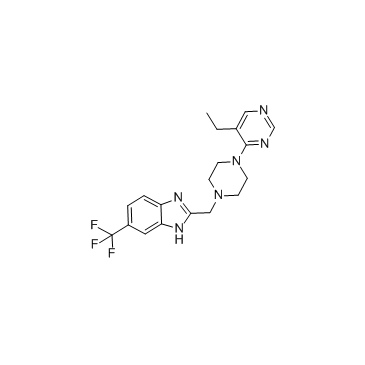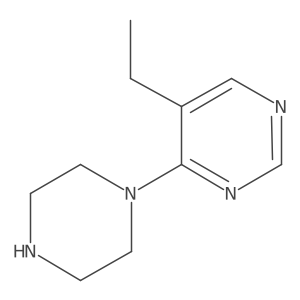PF-4708671

PF-4708671 structure
|
Common Name | PF-4708671 | ||
|---|---|---|---|---|
| CAS Number | 1255517-76-0 | Molecular Weight | 390.405 | |
| Density | 1.3±0.1 g/cm3 | Boiling Point | 572.8±50.0 °C at 760 mmHg | |
| Molecular Formula | C19H21F3N6 | Melting Point | N/A | |
| MSDS | Chinese USA | Flash Point | 300.2±30.1 °C | |
| Symbol |

GHS06 |
Signal Word | Danger | |
Use of PF-4708671PF-4708671 is a potent cell-permeable S6K1 inhibitor with a Ki of 20 nM and IC50 of 160 nM. |
| Name | 2-[[4-(5-ethylpyrimidin-4-yl)piperazin-1-yl]methyl]-6-(trifluoromethyl)-1H-benzimidazole |
|---|---|
| Synonym | More Synonyms |
| Description | PF-4708671 is a potent cell-permeable S6K1 inhibitor with a Ki of 20 nM and IC50 of 160 nM. |
|---|---|
| Related Catalog | |
| Target |
S6K1:160 nM (IC50) S6K1:20 nM (Ki) S6K2:65 μM (IC50) |
| In Vitro | PF-4708671 inhibits the activity of full-length S6K1 in vitro with a Ki of 20 nM, and S6K1 isolated from IGF1-stimulated HEK293 cells with an IC50 of 0.16 μM, and only inhibits very weakly the closely related S6K2 isoform (IC50 of 65 μM). PF-4708671 inhibits RSK1 (IC50 of 4.7 μM) and RSK2 (IC50 of 9.2 μM) over 20-fold less potently than S6K1. PF4708671 inhibits MSK1 (IC50 of 0.95 μM) 4-fold more weakly than S6K1[1]. HCT116 cells are treated with (i) vehicle (DMSO), (ii) OSI-906 (5 μM), (iii) PF-4708671 (10 μM), and (iv) OSI-906 (5 μM)+PF-4708671 (10 μM) for various amounts of time. HCT116 cells treated with OSI-906 alone (closed square) or PF4708671 alone (open circle) slightly inhibit cell growth. In contrast, proliferation in HCT116 cells is significantly inhibited after a 2-day treatment with the combination of OSI-906 and PF-4708671 (closed circle). A similar result is also observed when SW480 cells are treated with the combination of OSI-906 and PF-4708671. Colony formation also significantly reduces in OSI-906+PF-4708671-treated cells comparing with vehicle, OSI-906 alone, or PF-4708671 alone treated HCT116 or SW480 cells[2]. |
| In Vivo | The tumor growth rate in mice treated with the combination of OSI-906+PF-4708671 is significantly slower than that of OSI-906 alone (P=0.0189) or PF4708671 alone (P=0.0165) treated mice. The average tumor volume in the OSI-906+PF-4708671-treated mice is approximately 50% of that in mice treated with OSI-906 (P=0.0056) or PF-4708671 alone (P<0.001) at the end of a 15-day treatment[2]. |
| Cell Assay | GEO, HT29, SW480, and HCT116 cells are used. The effects of OSI-906 or the combination of OSI-906 and PF-4708671 on cell proliferation is determined with XTT and clonogenic assays. XTT assays are performed using the Cell Proliferation Kit II (XTT). For clonogenic assays, cells (1×103 cells/well) are seeded on a 6-well plate and subsequently treated with drugs (OSI-906 5 μM, PF-4708671 10 μM). After 1 week of incubation, cells are stained with 1% crystal violet, and the number of colonies is counted and recorded[2]. |
| Animal Admin | Mice[2] Five- to 6-week-old female athymic nude mice (Hsd:Athymic Nude-Foxn1nu) are randomly assigned to the following groups (5 mice/group). For injection of HT29-L and HT29-P cells, mice are treated with vehicle (25 mM tartaric acid) or OSI-906 (30 mg/kg) for 12 days. For injection of HCT116 cells, mice are treated with (i) vehicle (25 mM tartaric acid); (ii) OSI-906 alone (30 mg/kg); (iii) PF-4708671 alone (60 mg/kg); and (iv) OSI-906 (30 mg/kg)+PF-4708671 (60 mg/kg) and treated with drugs orally for 14 days. Vehicle and OSI-906 are given once per day and PF-4708671 is given once every other day. Twenty-four hours after the last treatment, the mice are sacrificed and the tumor weights were measured[2]. |
| References |
| Density | 1.3±0.1 g/cm3 |
|---|---|
| Boiling Point | 572.8±50.0 °C at 760 mmHg |
| Molecular Formula | C19H21F3N6 |
| Molecular Weight | 390.405 |
| Flash Point | 300.2±30.1 °C |
| Exact Mass | 390.177979 |
| PSA | 60.94000 |
| LogP | 3.20 |
| Appearance of Characters | off-white |
| Vapour Pressure | 0.0±1.6 mmHg at 25°C |
| Index of Refraction | 1.609 |
| InChIKey | FBLPQCAQRNSVHB-UHFFFAOYSA-N |
| SMILES | CCc1cncnc1N1CCN(Cc2nc3ccc(C(F)(F)F)cc3[nH]2)CC1 |
| Storage condition | Store at +4°C |
| Water Solubility | DMSO: ≥20mg/mL |
|
~% 
PF-4708671 CAS#:1255517-76-0 |
| Literature: Pearce, Laura R.; Alton, Gordon R.; Richter, Daniel T.; Kath, John C.; Lingardo, Laura; Chapman, Justin; Hwang, Catherine; Alessi, Dario R. Biochemical Journal, 2010 , vol. 431, # 2 p. 245 - 255 |
|
~% 
PF-4708671 CAS#:1255517-76-0 |
| Literature: Biochemical Journal, , vol. 431, # 2 p. 245 - 255 |
| Precursor 2 | |
|---|---|
| DownStream 0 | |
| 1H-Benzimidazole, 2-[[4-(5-ethyl-4-pyrimidinyl)-1-piperazinyl]methyl]-5-(trifluoromethyl)- |
| QC-8396 |
| HMS3263P20 |
| 5FI |
| 1H-Benzimidazole (2-[[4-(5-ethyl-4-pyrimidinyl)-1-piperazinyl]methyl]-6-(trifluoromethyl) |
| 2-{[4-(5-Ethyl-4-pyrimidinyl)-1-piperazinyl]methyl}-5-(trifluoromethyl)-1H-benzimidazole |
| 2-((4-(5-Ethylpyrimidin-4-yl)piperazin-1-yl)methyl)-5-(trifluoromethyl)-1H-benzo[d]imidazole |
| PF-4708671 |

![2-(CHLOROMETHYL)-6-(TRIFLUOROMETHYL)-1H-BENZO[D]IMIDAZOLE structure](https://image.chemsrc.com/caspic/467/107430-29-5.png)
